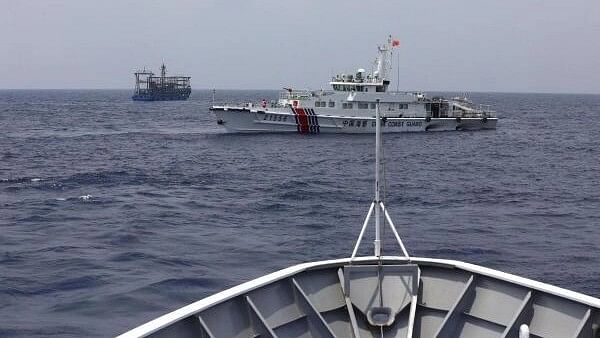
A Chinese Coast Guard ship is seen blocking the direction of a Philippine Coast Guard ship conducting a resupply mission for Filipino troops stationed at a grounded warship in the South China Sea.
Credit: Reuters File Photo
By Karishma Vaswani
A provisional arrangement between China and the Philippines, intended to smooth their troubles in the South China Sea, has quickly unraveled. Now more than ever, Manila and the international community need to call Beijing’s “grey zone” activities in the contested waters what they are: Illegal, coercive, aggressive and deceptive. This will bring further transparency to a situation that has the potential to turn into a major global flashpoint.
The moniker, known as ICAD, was first coined by a Filipino general. Grey-zone activities refer to provocative actions that aren’t so egregious they would demand a warlike response, but neither are they of a peaceful nature.
For Beijing, this has meant using water cannons to harass Manila’s vessels, and intimidating collisions in the waterway. The most recent clash was June 17 during a Filipino resupply mission to the BRP Sierra Madre, a rusty American World War II-era ship grounded on Second Thomas Shoal with a few Filipino marines and service members still onboard. Manila said a Chinese coast guard crew used bladed weapons to puncture boats, seized guns, and rammed Philippine vessels.
Deploying more forceful language for China’s behavior wouldn’t only allow Manila to press home the point that what Beijing is doing is wrong, but it could also help to focus the region on how to coordinate a better response. It would allow countries to consider more concrete measures they can take if the international community deemed that China’s actions are deceptive, or coercive and aggressive, and it could merit a wider discussion about what regional alliances might come into play. Right now, the Philippines is having to rely on its partner, the US, to help it ward off Beijing’s intimidation.
Bringing clarity to China’s grey-zone activities would dispel the “ambiguity” around the term itself, according to The Lowy Institute, an Australian think tank. The phrase is open to misinterpretation, and allows for a degree of doubt regarding Beijing’s original intentions, it believes.
It isn’t just the Philippines that has been the target of China’s coercive behavior. Earlier this year, a Chinese fighter jet intercepted an Australian helicopter in international waters. The incident prompted outrage, with Canberra saying it was an act that risked unsettling improving ties between the two countries.
The Philippines has been pushing for the term ICAD to be adopted because it has been the biggest target of Beijing’s assertiveness in the South China Sea. It could help from a legal perspective, Ray Powell, founder and director of SeaLight, a maritime transparency project of the Gordian Knot Center for National Security Innovation at Stanford University, told me. “The Filipinos have grown uncomfortable with grey-zone as a term. They want something more clarifying, and ICAD has the benefit of labeling these actions clearly.”
The right name can make all the difference. Beijing knows this, and uses it to its advantage. The South China Sea is called Ren’ai Jiao in all official Chinese documentation and public communications, harking back to the name used centuries ago by various dynasties, a historical legacy that it uses to justify its present-day claims over the waters. It insists on Taiwan being called Chinese Taipei in international sporting events. On Chinese maps, Beijing has renamed places on the border with India despite New Delhi firmly asserting its territorial rights over the area.
Manila, sensing the power of the name game, also decided to use its own for the parts of the South China Sea it claims. In September 2012, President Benigno Aquino III signed an order requiring all government agencies to use the name West Philippine Sea. In 2016, he brought Beijing to an international tribunal. The Permanent Court of Arbitration at the Hague Tribunal found in the Philippines’ favor, but China simply ignored the ruling.
The real test of China’s resolve will be the next resupply mission to the Sierra Madre. No doubt this issue will be top of the agenda for US Secretary of State Antony Blinken and US Defense Secretary Lloyd Austin as they embark on their Asia tours this week. The Philippines is a key stop for both diplomats, and it will be a chance to engage on the kind of support it needs. Words matter — now is the time to find the right ones.